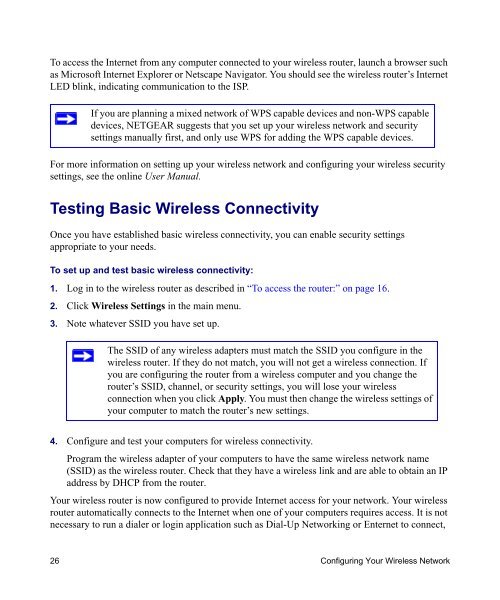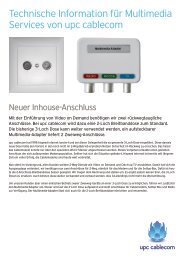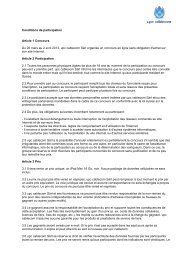Installing Your Wireless Router - upc cablecom
Installing Your Wireless Router - upc cablecom
Installing Your Wireless Router - upc cablecom
You also want an ePaper? Increase the reach of your titles
YUMPU automatically turns print PDFs into web optimized ePapers that Google loves.
To access the Internet from any computer connected to your wireless router, launch a browser such<br />
as Microsoft Internet Explorer or Netscape Navigator. You should see the wireless router’s Internet<br />
LED blink, indicating communication to the ISP.<br />
If you are planning a mixed network of WPS capable devices and non-WPS capable<br />
devices, NETGEAR suggests that you set up your wireless network and security<br />
settings manually first, and only use WPS for adding the WPS capable devices.<br />
For more information on setting up your wireless network and configuring your wireless security<br />
settings, see the online User Manual.<br />
Testing Basic <strong>Wireless</strong> Connectivity<br />
Once you have established basic wireless connectivity, you can enable security settings<br />
appropriate to your needs.<br />
To set up and test basic wireless connectivity:<br />
1. Log in to the wireless router as described in “To access the router:” on page 16.<br />
2. Click <strong>Wireless</strong> Settings in the main menu.<br />
3. Note whatever SSID you have set up.<br />
The SSID of any wireless adapters must match the SSID you configure in the<br />
wireless router. If they do not match, you will not get a wireless connection. If<br />
you are configuring the router from a wireless computer and you change the<br />
router’s SSID, channel, or security settings, you will lose your wireless<br />
connection when you click Apply. You must then change the wireless settings of<br />
your computer to match the router’s new settings.<br />
4. Configure and test your computers for wireless connectivity.<br />
Program the wireless adapter of your computers to have the same wireless network name<br />
(SSID) as the wireless router. Check that they have a wireless link and are able to obtain an IP<br />
address by DHCP from the router.<br />
<strong>Your</strong> wireless router is now configured to provide Internet access for your network. <strong>Your</strong> wireless<br />
router automatically connects to the Internet when one of your computers requires access. It is not<br />
necessary to run a dialer or login application such as Dial-Up Networking or Enternet to connect,<br />
26 Configuring <strong>Your</strong> <strong>Wireless</strong> Network

















